As the bilateral trade between Zimbabwe and South Africa continuously grows in favour of South Africa, it has become imperative that the two southern African countries come up with a plan to strike some sort of balance.
Not only do they need to ensure that Zimbabwe’s exports to its neighbour grow to sustainable levels, they need to make sure that South Africa’s exports into Zimbabwe do not crowd out local products.
Official figures show that South Africa is the single largest trading partner in Zimbabwe, accounting for at least 40 percent of total exports and 60 percent of total imports.
In 2015, bilateral trade between the two countries stood at $4,2 billion. Zimbabwe absorbed 71 percent of South Africa’s total exports while supplying only 38 percent of South African imports in the same period.


The problem with this state of affairs is that Zimbabwe has had to bear the brunt of a trade imbalance, more so in a situation where the depreciation of the South African rand (ZAR) against the United States dollar continues to undermine the competitiveness of local exports.
While Government has been trying to strike a balance between imports from South Africa and exports to that country through introduction of import duties on some locally produced goods, not much has changed.
And the country can only hope that the fresh calls for balance made at the 6th Investment and Trade Initiative conference held in Harare early this week will usher in new strategies that can finally usher in change.
Speaking at the conference which was attended by a 33-member South African business delegation, ZimTrade chief executive Sithembile Pilime said Zimbabwe’s main exports in 2015 were tobacco, minerals (gold, platinum, unwrought nickel), tea, cotton as well as raw skins and hides.
“Looking at the main exports to South Africa, there are no finished products but agricultural and mineral commodities. There is opportunity for investment in the processing of these commodities in order to diversify the export product mix of Zimbabwe,” she said.
While South Africa is the biggest trade partner, Zimbabwe does not feature prominently on the list of South Africa’s partners which include China, Germany, USA, Saudi Arabia and Japan.
“As Zimbabwe, we need to grow our exports and our countries’ companies can work together through partnerships, joint ventures and investments in the value addition of our numerous resources.
“In this way, we will increase trade between our countries,” Pilime said.
“South Africa already has a competitive edge over Zimbabwe and we acknowledge this. However, we would like to see a healthy balance of trade.”
While the visiting South African companies have received assistance from the Department of Trade and Industry through its Export Marketing and Investment Assistance (EMIA) scheme, there has been no such schemes for Zimbabwean companies. So, to achieve that balance, there is need to increase the level of investment between the two countries so that Zimbabwe can increase its production and allow for increased exports.
South African Trade and Industry Deputy Minister Mzwandile Masina told delegates at the conference that the Industrial Development Corporation and Development Bank of Southern Africa have approved funding to the tune of US$280 million for infrastructure building projects in Zimbabwe, incorporating both private and public partnerships.
He mentioned future investments into Zimbabwe by South African companies including $8,85 million by Tongaat-Hullet in the agro-processing sector, $1,2 million by Panasonic Business Systems in advanced manufacturing and $521 million to be invested by Nucoal in the coal, oil and gas sectors.
“You would note, ladies and gentlemen, the thrust of our investments are aimed at value addition and assisting Zimbabwe in building value chains that are critical in ensuring structural growth,” he said.
“South Africa remains committed to partnering with Zimbabwe in the realisation of our joint economic aspirations. This commitment has been translated into tangible initiatives over the years as evidenced by the five previous Investment and Trade Initiatives undertaken.”
Economists have also said Government must implement supply side policies, which aim to improve the productivity and competitiveness of the economy, in an effort to make Zimbabwean exports more competitive and attractive.
Zimbabwe’s Deputy Minister of Industry and Commerce Chiratidzo Mabuwa reiterated the importance of increased investments in value addition and beneficiation by South African companies as a way of balancing trade flows.
“In a bid to close this unhealthy trade relationship, I am happy that in 2014 Zimbabwe resumed exportation of its clothing products to South Africa under the 1964 Bilateral Trade agreement,” she said.
“The Government will continue to craft strategies and measures that seek to enforce implementation of value addition and beneficiation across our industries in order for the country to realise the true value of its assets.”
Hopefully, increased investments from South Africa instead of increased imports will be the best possible way to create a win-win situation for both countries.




